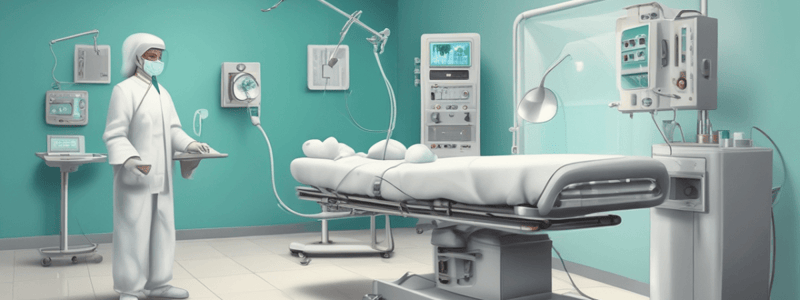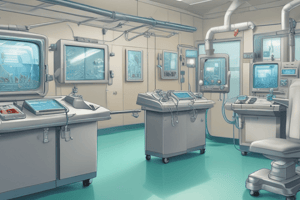Podcast
Questions and Answers
What is a disadvantage of using containers for packaging surgical instruments?
What is a disadvantage of using containers for packaging surgical instruments?
- They are lightweight and easy to lift.
- They eliminate the risk of filter dislodgement.
- They require additional space to store and entail extra effort for cleaning. (correct)
- They are smaller in size than wrapped trays.
What is a characteristic of peel-apart pouches?
What is a characteristic of peel-apart pouches?
- They are made of paper and have a transparent front.
- They are opaque and have a paper backing.
- They are transparent and have a metal backing.
- They are transparent and have a see-through front and paper backing. (correct)
What is a benefit of using see-through peel packaging?
What is a benefit of using see-through peel packaging?
- It increases the risk of filter dislodgement.
- It is a time-saving concept. (correct)
- It requires specialized equipment to seal.
- It is a time-consuming concept.
Why is sealing peel-apart pouches essential?
Why is sealing peel-apart pouches essential?
What type of pouches have adhesive manufactured into the open end of the bag?
What type of pouches have adhesive manufactured into the open end of the bag?
What is a potential risk associated with using containers?
What is a potential risk associated with using containers?
What is a characteristic of self-sealing pouches?
What is a characteristic of self-sealing pouches?
Why may a longer cycle time be required when using containers?
Why may a longer cycle time be required when using containers?
What is a disadvantage of containers compared to wrapped trays?
What is a disadvantage of containers compared to wrapped trays?
What is a benefit of using reels of peel-apart pouches?
What is a benefit of using reels of peel-apart pouches?
Why is it easy to identify packed devices in peel-apart pouches?
Why is it easy to identify packed devices in peel-apart pouches?
Flashcards are hidden until you start studying
Study Notes
Processing Metal Basins
- When processing metal basins, ensure they are positioned to allow moisture to drain during sterilization to prevent water droplets from forming.
- Use wicking material, such as surgical towels, to facilitate drainage and drying.
- Maintain a 1-inch size difference between multiple basins to avoid condensation accumulation.
Packaging
- The purpose of packaging is to hold and protect devices during sterilization and maintain sterility.
- Key requirements for packaging materials include:
- Providing an adequate barrier to microorganisms and particulates
- Being suitable for the items being sterilized
- Maintaining sterility of contents until opened
- Allowing sterilants to penetrate and contact surfaces
- Permitting removal of sterilants and aseptic delivery of contents
- Protecting contents from physical damage
- Ensuring complete and secure enclosure
- Being resistant to tears, abrasions, and punctures
- Ensuring tamper-proof sealing and air removal
Sterilization Flat Wrap
- Made of nonwoven Spunbond-meltblown-spunbond (SMS) fabrics and designed as a single-use product.
- Available in various sizes and weights.
- Wrapping techniques include:
- Sequential Wrapping: two layers of wrap material wrapped individually using a fold technique
- Simultaneous Wrapping: both layers of wrap material wrapped together simultaneously
Folding Techniques
- Square Fold Technique: used for heavier items
- Envelope Fold Technique: used for smaller items
Containers
- Rigid reusable containers are making a comeback due to improved technology and cost-effectiveness.
- Key considerations for using containers include:
- Easy disassembly for cleaning, drying, and storage
- Compatibility with sterilization and cleaning methods
- Lockable, tamperproof, and non-resealable
- Packed to allow penetration of sterilizing agents
- Ability to remove contents without contamination
- Filter and/or valve systems must be secure and in proper working order before sterilization.
- Disadvantages of using containers include:
- Ergonomic challenges due to heaviness
- Additional space required for storage
- Longer cycle time required
- Extra effort for cleaning and maintenance
- Potential risk of filter dislodge leading to instrument contamination
Pouches and Reels
- Various packaging materials available for individual surgical instruments.
- Peel-apart pouches with a see-through front and paper backing are often used for single devices or small loads.
- Sealing peel-apart pouches is essential to ensure sterility after autoclaving.
- Self-sealing pouches have adhesive manufactured into the open end and require a heat sealing machine or autoclave tape to create a seal.
- The see-through peel packaging is a time-saving concept.
Studying That Suits You
Use AI to generate personalized quizzes and flashcards to suit your learning preferences.




